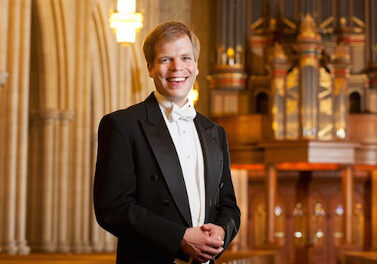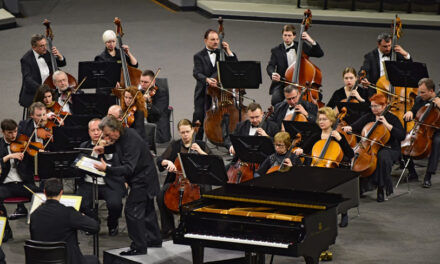The educational and engrossing program was entitled “Keyboard Connections.” In NC State’s Talley Ballroom, conductor Randolph Foy and the Raleigh Civic Chamber Orchestra connected with three diverse composers in works originally written for piano or organ.
The Legends, Op. 89, of Dvorák (1880-81), were written for piano four-hands. From the beginning Allegretto, the Bohemian spirit characteristic of that great composer was evident. The Allegro giusto movement carried on the flavor with a happy dance. History doesn’t seem to mention it, but a horn player must have had a powerful influence on Dvorák when he was arranging these pieces for orchestra. As went the horns, so went the flow of the music. It is hence doubly fortunate that Bill McHenry and his three colleagues came across as well prepared and effective, so dominant was their contribution.
Charles Ives’ “From the Salvation Army” (1896) existed for organ before it became his First String Quartet. Foy’s program notes pointed out that Ives employed “the playful juxtaposition of humor and profundity.” (To study Foy’s notes is generally to avail oneself of a valuable mini-education.) The fifteen or so strings, enhanced by the bass doubling the cellos, brought a pleasing fullness to the usual quartet sound in the two movements chosen. Employing tunes from that storied old hymn, the first movement took the hearer “From Greenland’s Icy Mountains,” with a fugue from low to high, all the way to “India’s coral strand” and “Afric’s sunny fountains.”The fourth movement urged one and all to “Stand Up for Jesus” and enjoined them to “put on the gospel armor.”
Anyone who has heard the original piano version of The Children’s Corner Suite (1908) knows of the endearing qualities of the six humorous vignettes meant by Debussy to evoke memories of much that is so charming about children. The bass made for a lovable little elephant, Jimbo in “Jimbo’s Lullaby.” The oboe brought on the affecting theme from “The Little Shepherd.” But none of the pieces quite measured up to the effectiveness and exultation of the closing “Golliwogg’s Cake-Walk.” The orchestration and the playing were masterly here in capturing the original spirit.
The program was educational as well as entertaining. The generous mix of students in the audience spoke well for their artistic future and for the series that serves them.












